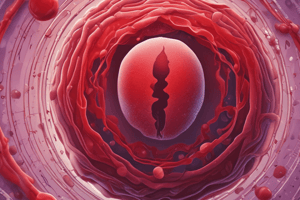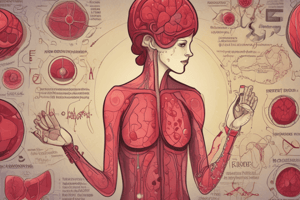Podcast
Questions and Answers
Match the following anemia types with their characteristics:
Match the following anemia types with their characteristics:
Macrocytic = Large cell size and high MCV and MCHC Normocytic = Normal cell size Microcytic = Small cell size Hypochromic = Pale color due to hemoglobin deficiency
Match the following symptoms with their possible causes of anemia:
Match the following symptoms with their possible causes of anemia:
Melena, epistaxis, hematemesis, or menorrhagia = Bleeding Jaundice and dark urine (in absence of liver disease) = Hemolysis Weight loss = Cancer Drowsiness = Anemia itself
Match the following nutritional deficiencies with their associated anemia types:
Match the following nutritional deficiencies with their associated anemia types:
Iron deficiency = Microcytic anemia Folate deficiency = Macrocytic anemia Vitamin B12 deficiency = Macrocytic anemia Copper deficiency = Microcytic anemia
Match the following anemia classification characteristics with their descriptions:
Match the following anemia classification characteristics with their descriptions:
Match the following symptoms of anemia with their descriptions:
Match the following symptoms of anemia with their descriptions:
Match the following terms with their definitions:
Match the following terms with their definitions:
Match the following micronutrients with their classification:
Match the following micronutrients with their classification:
Match the following groups with their risk level for micronutrient malnutrition:
Match the following groups with their risk level for micronutrient malnutrition:
Match the following causes of anemia with their corresponding descriptions:
Match the following causes of anemia with their corresponding descriptions:
Match the following strategies with their role in preventing micronutrient malnutrition:
Match the following strategies with their role in preventing micronutrient malnutrition:
Match the following terms with their definitions related to anemia:
Match the following terms with their definitions related to anemia:
Match the following consequences with their effects on health and economy:
Match the following consequences with their effects on health and economy:
Match the following foods with their characteristics:
Match the following foods with their characteristics:
Match the following diseases with their effects on red blood cells:
Match the following diseases with their effects on red blood cells:
Match the following types of blood loss with their descriptions:
Match the following types of blood loss with their descriptions:
Match the following terms with their descriptions:
Match the following terms with their descriptions:
Match the following nutritional deficiencies with their effects on red blood cells:
Match the following nutritional deficiencies with their effects on red blood cells:
Match the following organs with their roles in anemia:
Match the following organs with their roles in anemia:
Flashcards are hidden until you start studying



